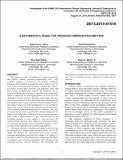A Mathematical Model for Pressure Compensating Emitters
Author(s)
Taylor, Katherine Anne; Shamshery, Pulkit; Wang, Ruoqian; Winter, Amos G.
DownloadA mathematical model.pdf (3.003Mb)
PUBLISHER_POLICY
Publisher Policy
Article is made available in accordance with the publisher's policy and may be subject to US copyright law. Please refer to the publisher's site for terms of use.
Terms of use
Metadata
Show full item recordAbstract
This paper presents a mathematical model investigating the physics behind pressure-compensating (PC) drip irrigation emitters. A network of PC emitters, commonly known as drip irrigation, is an efficient way to deliver water to crops while increasing yield. Irrigation can provide a means for farmer to grow more sensitive, and profitable crops and help billions of small-holder farmers lift themselves out of poverty. Making drip irrigation accessible and economically viable is important for developing farmers as most face the challenges of water scarcity, declining water tables and lack of access to an electrical grid. One of the main reasons for the low adoption rate of drip irrigation in the developing world is the relatively high cost of the pumping power. It is possible to reduce this cost by reducing the required activation pressure of the emitters, while maintaining the PC behavior. The work presented here provides a guide of how design changes in the emitter could allow for a reduction in the activation pressure from 1 bar to approximately 0.1 bar. This decrease in the activation pressure of each emitter in turn decreases the system driving pressure. This reduction of driving pressure will decrease the energy need of pumping, making a solar-powered system affordable for small-acreage farmers. This paper develops a mathematical model to describe the PC behavior in a commercially available emitter. It is a 2D model that explains the relationship between the pressure, structural deformation and fluid flow within a PC emitter. A parametric study has been performed to understand the effects of geometric and material parameters with regards to the activation pressure and PC behavior. This knowledge will help guide the designs and prototypes of optimized emitters with a lower activation pressure, while also providing the PC behavior.
Date issued
2015-08Department
Massachusetts Institute of Technology. Global Engineering and Research Laboratory; MIT-SUTD Collaboration Office; Massachusetts Institute of Technology. Department of Civil and Environmental Engineering; Massachusetts Institute of Technology. Department of Mechanical Engineering; MIT Energy InitiativeJournal
Volume 2A: 41st Design Automation Conference
Publisher
American Society of Mechanical Engineers
Citation
Taylor, Katherine A., Pulkit Shamshery, Ruo-Qian Wang, and Amos G. Winter. “A Mathematical Model for Pressure Compensating Emitters.” Volume 2A: 41st Design Automation Conference (August 2, 2015).
Version: Final published version
ISBN
978-0-7918-5707-6